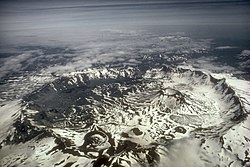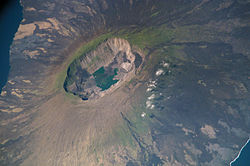Volcanic caldera
A volcanic caldera is a large depression, different from a crater, caused by different factors, such as the collapse of a magma chamber or by landslides: they originate when a volcanic edifice greatly increases its height with respect to its base, becoming unstable and collapsing in favor of gravity, as is the case of Las Cañadas del Teide in Tenerife (Canary Islands, Spain). Rarer is the formation of a caldera by phreatic explosion, as is the case of the Caldera de Bandama on the island of Gran Canaria, also in the Canary Islands, produced when the ascending basaltic magma finds an aquifer on its way, causing a colossal explosion by converting to water into steam under enormous pressure. Another type of caldera is produced by the spillage of lava from the crater to the outside, of which the Caldera de Taburiente, located on another island in the Spanish Canary Islands archipelago: La Palma, is a good example. This last caldera is the one that has served as a model for this type of volcanic structure, although it is not so appropriate because the caldera itself was emptied in a short time by the lava flow to the west.
Origin and etymology
The Spanish term caldera (from the Latin caldaria) was introduced into international geological literature by the German geologist Leopold von Buch in 1825, in his study of the Canary Islands following his voyage of 1815, in which he visited Teide and the Caldera de Taburiente, in La Palma, from which he took his name. Actually, Buch adopted the name that the inhabitants of the island of La Palma already gave to the Aceró (Taburiente) area, but in none of his texts does he allude to introducing the term caldera into geological language.;
Types of volcanic calderas
Hawaiian Volcanoes
Strictly speaking, a volcanic caldera is a crater of larger than normal proportions, with fairly fluid and hot lava and non-explosive and very prolonged eruptions, as in Hawaiian volcanoes. The lava lake that forms inside a caldera is formed by very hot and fluid lava, of the basaltic type, which is why it is very poor in silica. The surface of the caldera can form a crust on contact with the outside, but the molten lava always remains at a shallow depth below it. The irregular crust inside the caldera appears at the calmest intervals in its eruptive history, while the edges slope very gently outward, as can be seen in the image of the Halemaumau caldera (Kīlauea Volcano, Island of Hawaii).
Lakes formed later in inactive calderas are called maars.
Sinking boilers
When the crust that forms on the surface of a caldera sinks into the liquid lava due to the increase in density that occurs when it cools, the level of the caldera decreases and an annular scarp is formed around the lava. same as the one seen on the southern edge of Teide, which can be seen in the satellite image (in Las Cañadas del Teide) and in the photographs of this volcano. Before the cone sinks, the magma can descend from the roof of the chamber, which is called a volcanic climax. In turn, this subsidence in the lava can produce the birth of a volcanic cone, on one side of the caldera, whose materials are formed by the rise of eruptive materials produced by the increase in pressure with the descent of the material that is leaving. cooling on the surface of the boiler. This volcanic cone forms a kind of safety valve that spews out pyroclastics (ash, bombs, lapilli, sand and volcanic glass) and thus compensates for the drop in the level of the caldera. This is the reason for the formation of Teide (which therefore rose later as the level of the caldera fell) and the volcanic cone that can be seen in the Aniakchak caldera, in Alaska. The schematic drawing of the formation of a caldera shows us this process. In the case of Mount Mazama, whose eruption formed the caldera that gave rise to Crater Lake (in Oregon, United States), we see that the formation of the cone that forms Wizard Island is after the collapse of the caldera and its cooling., and since it is lava that becomes impermeable when it cools down, a lake can form, as is the case represented in the diagram. And this lake differs from a maar, in the steeper slope around the crater.
Calderas emptied by lava flows
This is the case of the Caldera de Taburiente, located in the Canary Islands, on the island of La Palma. When the caldera still contained more or less liquid lava inside, the crater wall opened at one point, through which the lava from inside quickly poured out, forming what is now known as Barranco de Las Angustias. For this reason, the walls of the caldera are almost vertical, since the drop in the level of the lava occurred very quickly. The internal slopes of this caldera, almost one km in an almost vertical direction, can be seen in the image of the Balcón de Taburiente.
This is also the case of La Caldereta, a smaller caldera located on the eastern coast of the Island of La Palma and whose spillage towards the north provided the necessary foundation to build the city of Santa Cruz de La Palma. Nowadays, even the crater of La Caldereta itself is urbanized and inhabited.
Finally, most of the volcanoes in the Galapagos, especially on Fernandina Island and others, are subsidence calderas and in most cases, subsidence was due to lateral underground spills, so the The lava level inside the caldera decreased, as can be seen on the aforementioned island.
Characteristics of lava in calderas and volcanoes
There is a direct correspondence between the greater or lesser fluidity (or viscosity, inversely) of the lava and the characteristics in terms of height and slope of the volcanoes they produce, in addition to the more or less explosive nature of the eruptions corresponding.
- A volcano with very hot and fluid lava will tend to form cones of very little slope and very widespread, with quite quiet eruptions of Hawaiian type. In this case boilers are usually formed.
- A very viscous lava volcano (relatively cold temperature) tend to form fairly high and abrupt cones, with strong slopes.
- In cases of extreme viscosity (fighting blows) a volcanic python is usually formed by the extrusion of a fairly cold magma and which is drastically solidified for two important reasons:
- The relatively cold temperature, as already said.
- The violent decrease in the pressure as the lava leaves the surface. That is, when the lava was at some depth, it was in a liquid state due to the enormous pressure it endured. When going to the surface, this pressure decreases so the lava solidifies abruptly.
Notable Boilers
In Europe
- Caldera de los Campos Flégreos, Campania, (Italy).
In Africa
- Caldera de Bandama, Gran Canaria, Canary Islands (Spain)
- Caldera de Las Cañadas, Tenerife, Canary Islands (Spain)
- Caldera de Taburiente, La Palma, Canary Islands (Spain)
- Caldera de Tejeda, Gran Canaria, Canary Islands (Spain)
- Chã das Caldeiras, Cape Verde
- Monte Elgon, Uganda and Kenya
- Volcano Nyragongo, Tanzania
- Caldera de Luba, Bioko, Equatorial Guinea
In America
- Yellowstone in Wyoming, Montana, Idaho, United States
- Caldera de La Garita, is a large volcanic caldera located in the mountains of San Juan, near Creede (southwest of Colorado, United States)
- Caldera Aniakchak, Alaska, United States
- Crater Lake in Oregon, United States
- Chichonal, Chiapas, Mexico
- Sierra Primavera, in Zapopan, Jalisco, Mexico
- Volcano La Caldera, State of Mexico
- Los Humeros en Puebla, Mexico
- Argentina
- Cerro Galán
- Caviahue boiler
- Pino Hachado Caldera
- Oak
- Volcano Caldera Diamante
- Ecuador
- Cotopaxi
- Pululahua
- Cuicocha
- Quilotoa
- The Altar
- Caldera de Chacana
- Caldera de Chalupas
- Galapagos Islands, with a wide variety of volcanic boilers:
- Fernandina Island: Volcano The Summit
- Isabella Island: Top boilers: Ecuador, Wolf, Darwin and Alcedo.
- Colombia
- Machin Volcano, near Cajamarca, Tolima
- Volcano El Escondido, Caldas
- Chile
- Caldera La Pacana
- Laguna del Maule
- Caldera Diamante
- Volcano Sollipulli
- Cordillera Nevada
- Rano Kau, Easter Island.
- Volcano Chaitén
- Hudson Volcano
- Volcano Quetrupillan
- Volcano Puyehue
- Pumpkins (volcano)
- Costa Rica
- Caldera Guayabo (Guanacaste, Costa Rica)
- Palmares (Costa Rica)
- Nicaragua
- Volcano Masaya (Masaya, Nicaragua)
- El Salvador
- Lake Ilopango (San Salvador, El Salvador)
- Lake Coatepeque (Santa Ana, El Salvador)
- Guatemala
- Caldera Amatitlán (Guatemala, Guatemala)
- Caldera de Atitlán (Sololá, Guatemala)
- Lago de Ayarza (Santa Rosa, Guatemala)
- Caldera de Barahona (Sacatepéquez, Guatemala)
- Panama
- El Valle de Antón (Coclé, Panama)
In Asia
- Philippines
- Pinatubo (Luzón)
- Taal (Luzón)
- Indonesia
- Krakatoa, Sunda Strait
- Tambora (Sumbawa)
- Lake Toba (Sumatra)
- Japan:
- Caldera Aira (Kagoshima)
- Monte Aso (Kumamoto)
- Lake Towada (Aomori)
- Tazawa (Akita)
- Kikai Volcano (Kagoshima)
- Lake Ashi (Kanagawa)
- Other countries
- Monte Halla, (South Korea)
- Caldera Tao-Rusyr (Onekotan, Russia)
In Oceania
- Lake Taupo, New Zealand (North Island)
- Rano Kau, Easter Island
Contenido relacionado
Zoo Garden
Sodium chloride
Ejection cone




